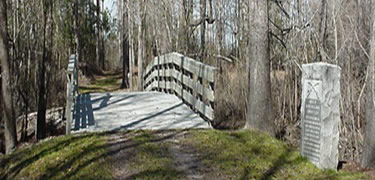First In Freedom
As a new resident of a new state, I have been going through the ritual of getting a new driver’s license, voter registration, car registration and all the other obligations that come with a move. When I got to the front of the line for a North Carolina license plate for my car, I was asked if I wanted the plate to read “First In Flight” or “First In Freedom.” Being an Ohio native, I knew all about the Wright Brothers and Kitty Hawk. I even visited the hill where Wilbur and Orville first got their idea off the ground, literally. But First In Freedom?

North Carolina State Flag
Evidently, I have a lot to learn.
As it turns out, North Carolinians have always been a determined lot. By the year 1776, they had grown tired of being under the harsh rule of King George, which was strictly imposed in the colony by Josiah Martin, the governor. He had inherited several problems from the former governor and for a time worked to correct them, but his fierce loyalty to the crown proved to be his undoing. North Carolinians formed the First Provincial Congress in 1774 and held Mr. Martin in contempt.
Fearing for his family’s safety, Martin shuffled his wife and their eight children to New York and he fled to Fort Johnston, near present day Southport, until a plot was unveiled that colonists had plans to take the fort. He then moved his operation to a war ship in the waters off the coast. In January, 1776, he received word from England that his plan to restore his authority had been approved and England was sending troops to assist in his efforts. In the meantime, he was to pull together an army of loyalists and Highland Scots from the area. They amassed near present day Fayetteville under the command of Brig. Gen. Donald MacDonald to await the regiments en route from England.
Determined to become self-sufficient or die trying, colonists under the leadership of Col. James Moore attempted to foil the rendezvous between MacDonald and the British forces by blocking the route leading to Wilmington, where the British troops were scheduled to land. Upon spotting a bridge at Moore’s Creek, the colonel determined it was the perfect spot to take a stand. Col. Alexander Lillington and Col. Richard Caswell, under orders from Moore, took up defensive positions, placing the bulk of the men between the creek and Wilmington, with 950 guarding the bridge over the wide swamp-like creek below. Once the men were across, planks were removed from the bridge and the girders were greased, to impede the progress of the British and Loyalist troops.

Moores Creek National Battlefield. Photo Courtesy of the National Park Service.
When the Loyalist troops came upon Caswell’s abandoned camp in the morning of February 27, 1776, they mistakenly thought the colonists were in retreat and marched toward victory. With bagpipes playing, the British forces stormed the remnants of the bridge, but only a few made it across. The battle lasted only three minutes. 70 Highlanders were dead or wounded, 850 were captured and only one colonist died as a result of the battle.
One thousand hardy souls from North Carolina claimed victory at Moore’s Creek Bridge near present-day Wilmington, NC. This was technically the first conflict of the American Revolution.
This encounter ended British control of the colony of North Carolina and inspired the other colonists to take up the fight. On April 12, 1776, the colony became the first to officially call for freedom from British rule, thereby becoming the first colony to take a stand in the cause for freedom. The Declaration of Independence was adopted three months later by the Continental Congress.
The site of this important battle has been preserved and a reconstructed bridge is in place at the site, under the operation of the National Park Service. This 86-acre park is located near Currie, NC.
https://www.ncpedia.org/moores-creek-bridge-battle
https://en.wikipedia.org/wiki/Moores_Creek_National_Battlefield
_________________________________________________________________________________________
Becky Lower is a recent transplant to North Carolina and swears her next license plate will read “First In Freedom.”
Pingback: First In Freedom — History Imagined – Cavin Apodo
I never knew about North Carolina and their part in the American Revolution. Interesting to read and very informative.
LikeLike
Who knew the North Carolinians were such rebel rousers, eh?
LikeLike
Awesome Becky, a great piece. I sure love reading your history blog. And God bless you in your new home in NC.
LikeLike
I know! It was never in our history books in Ohio. Eye-opening, to be sure.
LikeLike
Great history lesson. Never knew so much meaning could be ascribed to your license plate. I have a cousin who moved to NC a couple years go. Will share this story with him… and find out what’s on his plate 😉
LikeLike
Thanks, Kim. I was pleasantly surprised to find out North Carolina’s part in the Revolutionary War. I moved from a small town in Ohio whose claim to fame was they started the Civil War. Nice to know I can still lay claim to beginning a revolution of some kind.
LikeLiked by 1 person
Fascinating story! I’d never heard it before
LikeLike
I’m learning a lot about my new state in a short amount of time.
LikeLiked by 1 person
Really interesting, although all battles and wars upset me anymore. Brave souls on both sides.
LikeLike